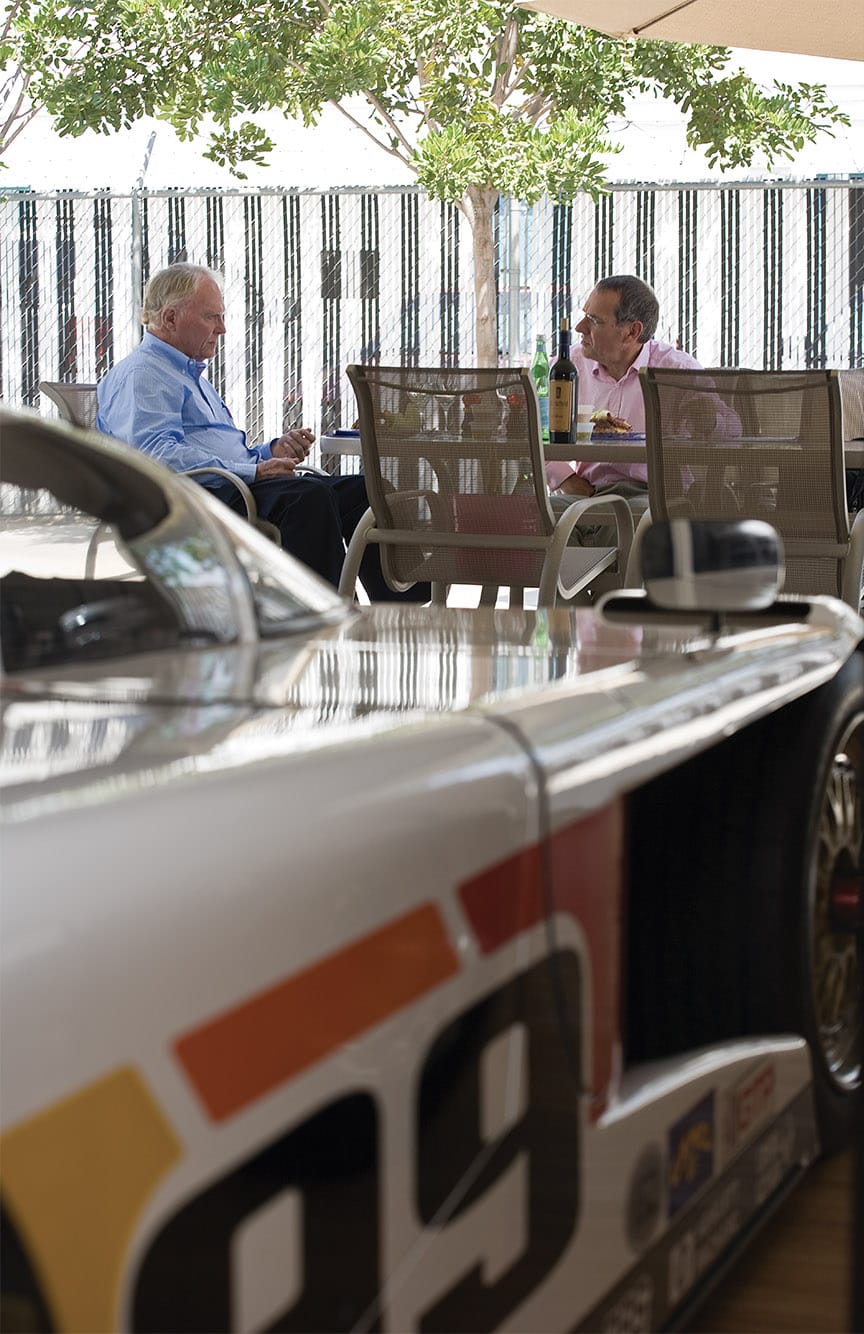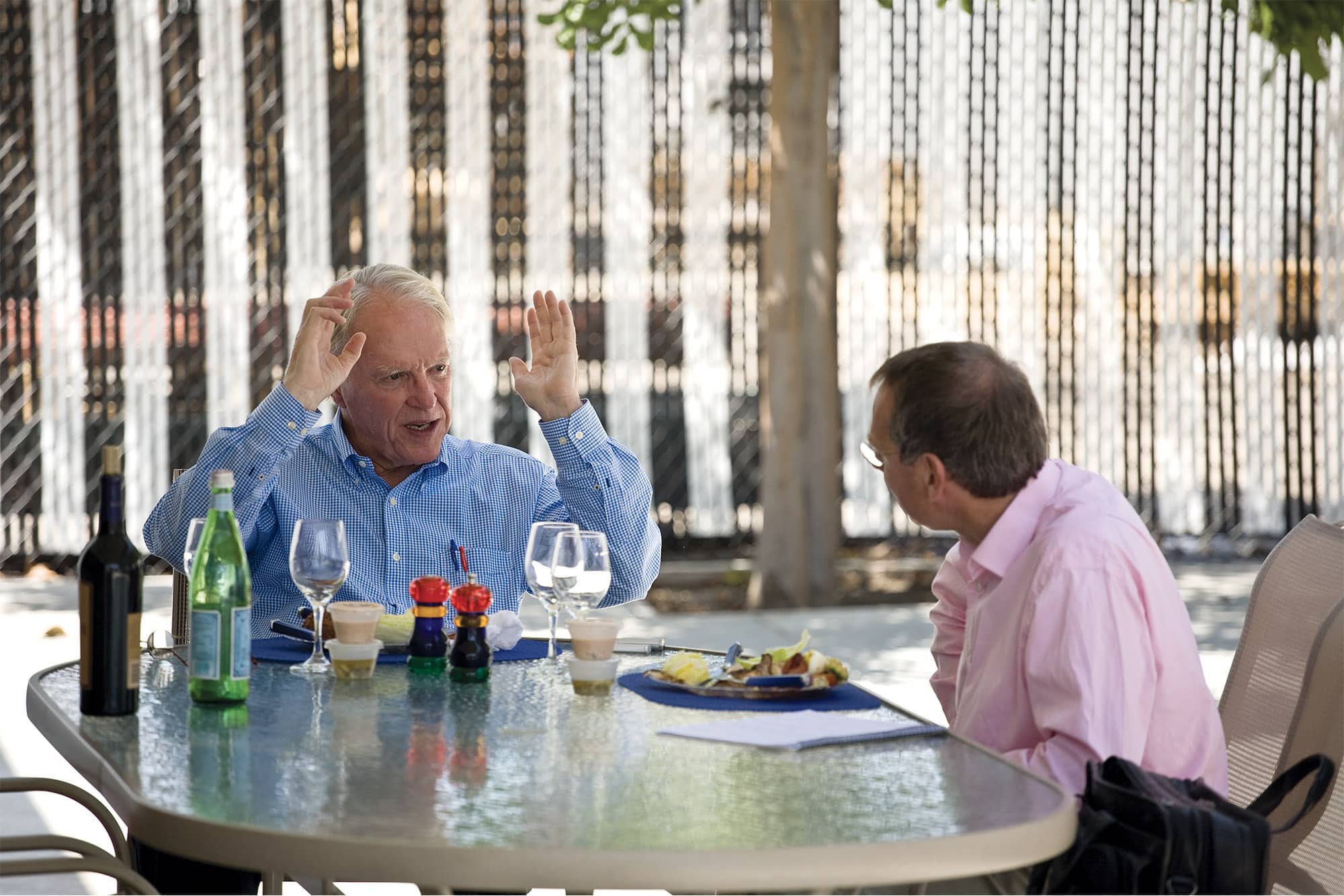Lunch with... Dan Gurney
This individualist has achieved more than seems possible during a remarkable motor sport career. What follows is just a taster – the rest he is busy crafting into a long-awaited autobiography.
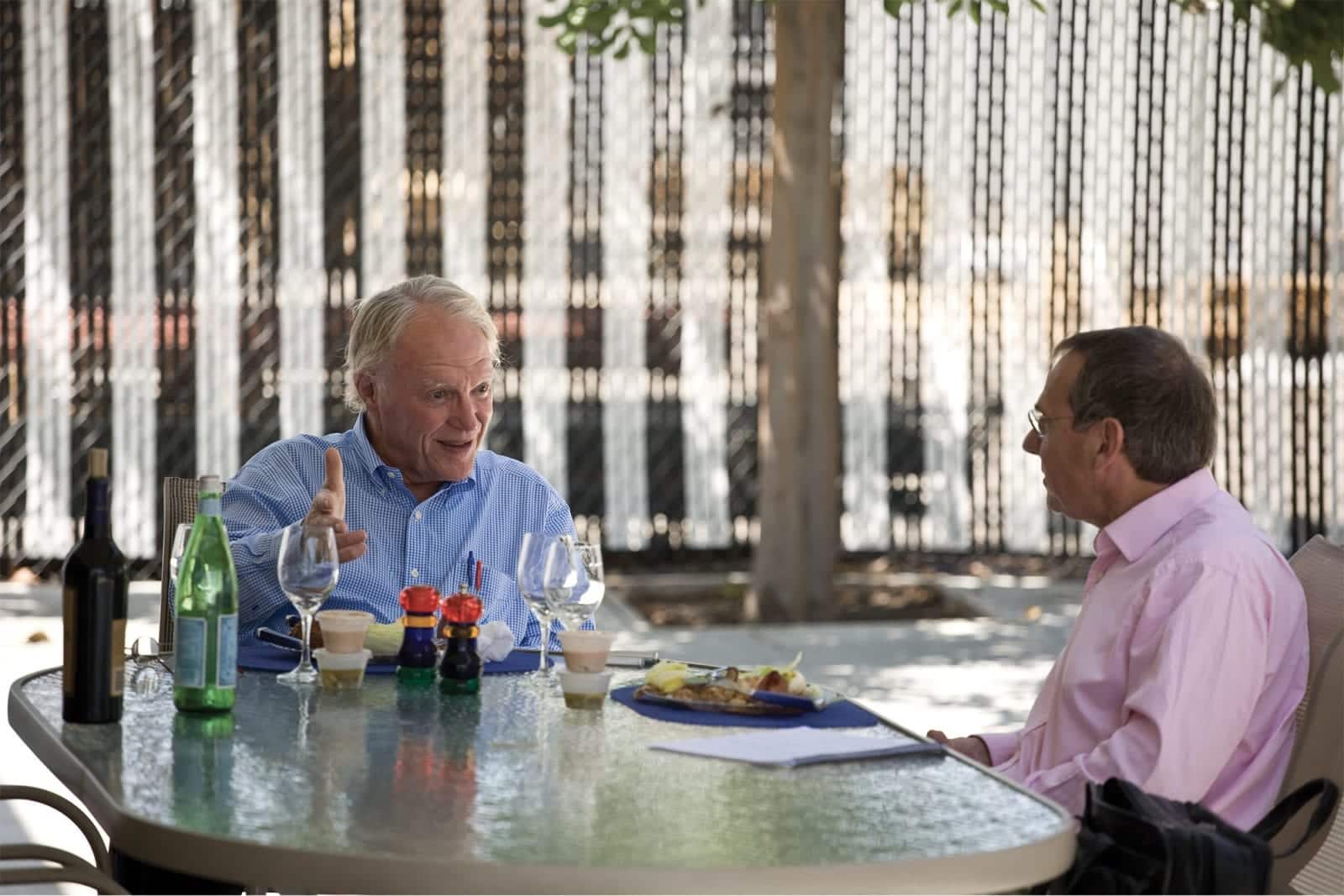
photobob.com
Ever since this “Lunch With…” caper began, at the top of my Wanted list has been Daniel Sexton Gurney. This is a man who drove for Ferrari in the 1950s, who spearheaded Porsche’s foray into Formula 1, and who won Le Mans for Ford. A patriot who built and drove the first American F1 car ever to win a Grand Prix. A victor in F1, sports cars and USAC – sometimes in the same season – and also in Can-Am, Trans-Am and NASCAR. A race car manufacturer too, who ran front-line teams in Indycar, Champ Car, Formula 5000, Trans-Am and IMSA. And a racer acknowledged by his peers to be one of the very best: famously, the man whom Jim Clark regarded as his most serious rival.
I knew Dan Gurney to be a courteous and deep-thinking man who would make a wonderful lunch guest. The problem was, he didn’t want to have lunch with me. Or, rather, he was very happy to invite me to lunch at his Eagles’ eyrie, but he wouldn’t be interviewed. The reason was a good one: for a while now, Dan has been working on his autobiography. There have been other books about his extraordinary life, but none authored by him. This will be the real story, and an important addition to racing’s written-down history because, throughout a golden era, Dan was there. So he has decreed: until the book is done, no more interviews.
But Dan’s a long-time Motor Sport reader. So, with typical generosity, he decided that he would, after all, talk to me about his career, but would keep back some of the detail. We agreed that my piece had to be an amuse-bouche for the autobiography. And he vetoed questions about his friends who are no longer around – Jimmy Clark, Peter Revson, Bruce McLaren, Swede Savage, Ken Miles, Phil Hill, Denny Hulme, Cliff Allison and many more. It’s a melancholy list, and he still feels their loss too keenly. He will say what he wants to say about them in the book.
The neat, unobtrusive facility in Santa Ana, south of Los Angeles, has been the centre of Dan’s working life ever since he set up All American Racers in 1964. Today it is humming with precision engineering and prototype work, and also development of the revolutionary Alligator motorcycle that has been a Gurney project since the 1990s. Dan is 78 now, but he likes to go to work “just about every day”: he remains president of AAR, with his son Justin as general manager. For 40 years a key member of the team has been Dan’s wife Evi, whom he first met when he was racing for Porsche. She was PA to competitions boss Huschke von Hanstein, and later ran Porsche’s press office. One of his 85 staff is the legendary fabricating genius Phil Remington, who was with Eagle throughout its heyday and still works there full-time, aged 88. People tend to stay loyal to Dan.
His big office is crammed with memorabilia, but it’s a measure of the man’s modesty that many of the framed photographs that cover the walls are not of him but of friends, fellow drivers, men he worked with, people he admired or wants to remember – like the iconic shot of Fangio drifting his 250F Maserati through the downhill curves at Rouen. There’s also a small museum of significant Eagles down the years. On the patio lunch is laid out in the sunshine: fresh salads, good Californian wine and coffee.
Dan was born on Long Island, New York – his father was a leading bass baritone at the Metropolitan Opera – but when he was 17 the family moved to California. His father set up an avocado farm, ironically not far from where the Riverside circuit would later be built. But for Dan, first it was hotrods. “In my teens I put a Mercury flat-head in an old Model A, took it to Bonneville and went 130mph on methanol. We were proud of that.” There was impromptu drag racing too, but in 1955, home after a spell in the Korean War as a gunner, he decided that road racing held more appeal. So he bought a Triumph TR2, and had his first race at Torrey Pines.
Soon, looking for more speed, he bought a Porsche Speedster. “I was working at an engineering firm for $1.12 an hour, so I went to the bank for the money. In those days you could do that.” Soon the money was gone, and Dan realised he’d have to rely on talking his way into other people’s cars. “One day I was up at Willow Springs and these two fellows with a Corvette were having trouble getting in a good lap. So I offered to show them how.” Dan beat the class lap record, and found himself co-opted to drive a Corvette at the inaugural meeting at the new Riverside track. He won conclusively, beating the fastest 300SL Mercedes by almost half a minute, and finished sixth in the main event against proper sports-racers. The Corvette’s owner, Cal Bailey, worked for millionaire building contractor Frank Arciero, who had a big 4.9-litre Ferrari with an evil reputation.
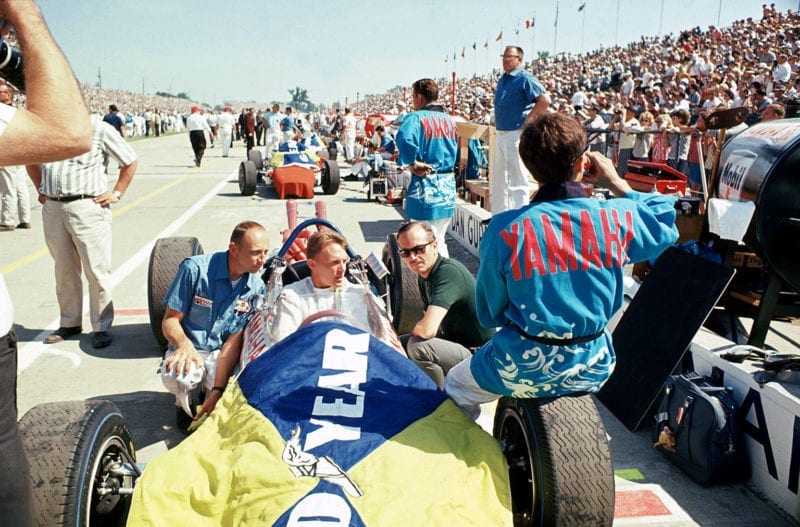
Dan with Colin Chapman at Indy in 1965. He retired his self-run Lotus Ford after 42 laps with gear trouble
Motorsport Images
“It had been rebuilt after a wreck and ended up not very user-friendly. Arciero asked me to try it at Willow, so first I spun it around on the pit apron to get a feel of it. I had to modify my driving style to deal with what the car wanted – not the first time I’d had to do that, or the last. Then I went out and got under the outright lap record. I was lucky because it wasn’t a car everybody was clamouring to get into, but it was certainly fast.”
*
A string of wins in the big Ferrari got Dan noticed, but it didn’t go down well at his place of work. “I was in line for more responsibility, but they told me I’d have to stop racing. I didn’t, of course, so I got fired. I had a wife and two small children by now, and I found myself standing in line at the unemployment office. I felt like a gigantic failure. My problem was I wanted to do road racing. In oval racing you could make a living, but there were no professional road racers in the US then. Things were looking pretty bleak. Then I got a phone call from Luigi Chinetti, Ferrari’s man in New York who ran NART [the North American Racing Team]. In baseball they have the farm system, where top teams watch the minor leagues for any new talent coming along. Well, I didn’t realise it, but Chinetti was doing that, following the American races and keeping Enzo posted about what was going on. And he offered me a drive at Le Mans.”
So Dan flew to Europe for the first time. In the 24 Hours he was paired with Bruce Kessler in a NART Testa Rossa, and in dreadfully wet conditions they got the car up into fourth place. Kessler was at the wheel when the Jaguar D-type of Jean-Marie Brousselet crashed fatally on the Dunlop Curve. The remains of the D-type cannoned into the path of the Ferrari, which rolled and caught fire. Two weeks later, in the Reims 12 Hours, Dan shared a Ferrari 250GT with André Guelfi, and they got up to second place before Guelfi crashed.
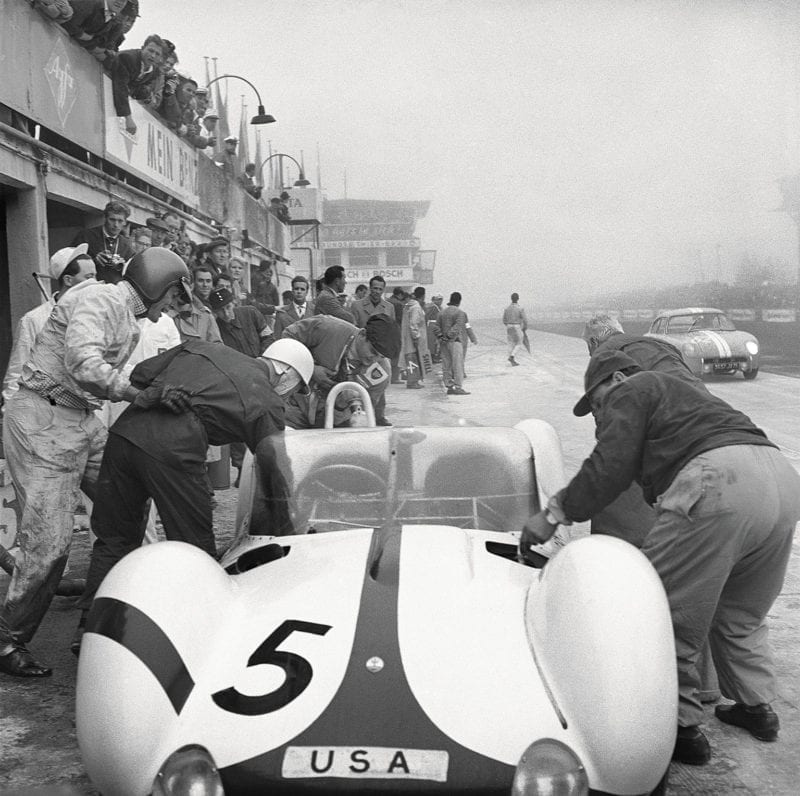
Taking over Maserati from Moss in 1960 Nurburgring 1000km, en route to victory
Motorsport Images
Dan stayed in Europe for several months, travelling with Troy Ruttman and his wife Beverley in a Renault Dauphine. “We had a wonderful time. Troy was a charismatic guy who’d won the Indy 500 at the age of 22 – the youngest winner ever. He was a gifted racer, did the Carrera Panamericana in a Mercury sedan too. But winning Indy at that age was more than he could cope with, and he fell in with the wrong people, did a lot of drinking and carousing. He was sampling F1 in a Scuderia Centro-Sud Maserati 250F, and we used the Dauphine to learn the ’Ring. It was OK for the downhill parts, but uphill it was hopeless! Bernard Cahier fixed me up with a little Osca for the sports car race before the German GP, and I was down to drive an Ecurie Ecosse D-type at Silverstone, but Masten Gregory crashed it. And I got to test a Centro-Sud Maserati 250F at Modena.”
Back in America he continued to race for Arciero and NART, but then Chinetti came on the phone again. Ferrari had lost Peter Collins and Luigi Musso in fatal accidents and Mike Hawthorn to retirement, and Dan was summoned for a test at Modena. “I drove a 2-litre sports car, then a 3-litre sports car, then an F1 car. Two days later, at Monza, they put me in a Testa Rossa. It was raining, and [Ferrari test driver] Martino Severi, who knew every inch of the place, set a time first. I had a wad of 10,000 lire notes to keep me alive in Italy, and I didn’t want to leave them in the pits, so I stuffed them in my driver’s suit. I didn’t fit the seat very well anyway, and the pressure of those banknotes was just in the wrong place, so my right leg went to sleep after a few laps. I managed to get through it, equalled Severi’s time although I didn’t beat it. Then, on my coming-in lap, I spun at the Parabolica. I didn’t hit anything, and drove on to the pits, and they never knew.
“I flew back to the US not really knowing what to make of all this. Then a telegram arrived from Ferrari. It offered me a ride in the 1959 World Sports Car Championship, for a retainer of $163 a month.” Joining a team that included Tony Brooks, Jean Behra, Phil Hill, Olivier Gendebien and Cliff Allison, Dan shared the winning car at Sebring, led the Targa Florio, held second at the ’Ring until clutch trouble dropped him to fifth and, teamed with Behra, led Le Mans for five hours. And he was called to Monza for another F1 test. “It was the latest 246. Enzo was there, and Behra had just got under the lap record with it. I did about 10 laps, and then they changed the 15-inch front wheels for 16s. They told me ‘Guarda’, watch out. After a couple of laps to warm the tyres, I went down to my usual braking point at the Parabolica and the fronts locked. I lifted and tried again, and they locked again, and by now I was pretty far in. I managed to spin the car, but it hit the bank, almost spat me out as it banged and bounced, and ended up pretty bent. I figured, OK Dan, you’ve really done it now. Back at the pits they said, ‘Too bad. By the way, in those first 10 laps you equalled Behra’s time.’ Three weeks later I was driving in my first Grand Prix.”
That was at Reims, where his engine blew. But he did three more for Ferrari, and amazingly finished second (Avus), third (Monsanto Park) and fourth (Monza). “The Portuguese race got people’s attention because I was quickest Ferrari on what was thought to be a tricky road circuit. Phil was coming into his own then, but Tony Brooks was rightly considered to be team leader, and I had the utmost respect for him. You’re always searching for a measure of where you stand. That was what mattered to me.”
At Reims Behra had his famous argument with Romolo Tavoni, threw a punch and was sacked from the team. “I liked Tavoni. He was a big tall gangling person, worldly in an appealing way, and you sensed that if you worked for Enzo you’d better pay him some respect. When he and Behra had their difficulty I didn’t understand it, because I really admired Jean. Enzo seemed to foment that sort of trouble: one of his weapons was to frighten people if he could. Four weeks later Jean went over the Avus banking in the rain during the sports car race.
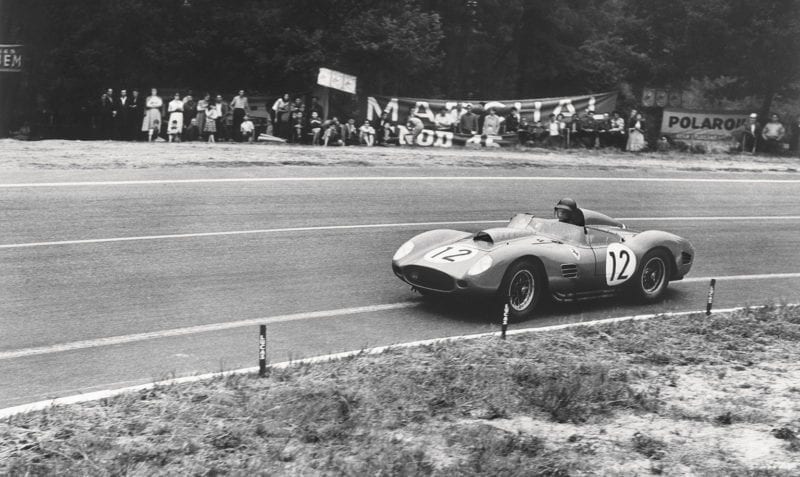
Gurney led Le Mans in 1959, teamed with Behra in Ferrari 250
Motorsport Images
“There were a lot of unknowns at Avus. The height and contour of the banking meant you’d be in trouble if you lost it there. I’d heard the bricks got very slippery in the wet, but we didn’t run in the rain.”
Dan’s F1 career had got off to a great start, and he was hailed as the discovery of the season, but for 1960 he opted to go to BRM. “I realised mid-engined was the way things were going: Cooper had proved that. At that point Enzo was still saying the horse should be in front of the carriage. The BRMs looked beautifully made, lots of nice machining, and I assumed they would be as strong and durable as the Ferrari, I thought all racing cars were like that. But I was wrong.”
That season with the new rear-engined BRM was a disaster. Dan retired from every championship round except Silverstone, where a long pitstop delayed him. And at Zandvoort the hydraulic pipe to the single rear transmission brake ruptured as he hit the brakes at 160mph. The BRM leaped a sand dune, went through a barbed-wire fence, and killed a young spectator. Dan was lucky to escape serious injury. “At the time Stirling was the acknowledged deep-braking guy, and I was trying my best to equal him. After that I altered my braking technique, never went quite so deep any more.”
The same year, paired with Stirling Moss in a Camoradi Maserati Birdcage, he scored a great victory in the Nürburgring 1000Kms. Moss said later, “Along with Fangio, Dan was the best co-driver I ever had.” Dan returns the compliment. “Stirling was the superstar, without any question. When I wasn’t racing myself I’d go out and watch how he drove. Sharing with him was a huge privilege. You want to know how you measure up, you share a car with Stirling.” In treacherous conditions of drizzle and fog, Moss handed over to Gurney with a full minute’s lead, which Gurney was consolidating when the Maserati broke an oil pipe. “Suddenly the cockpit was flooded with hot oil, sloshing forward when I braked and back when I accelerated. I nursed the car seven miles back to the pits – building hotrod engines as a teenager had given me mechanical sensitivity – but when [Maserati chief mechanic] Guerrino Bertocchi saw all the mess there was quite a bit of Italian opera. I persuaded him the engine might still be OK, they just had to mend the oil line and clean it up.” The stop lost nearly six minutes, but after a brilliant charge back up the field Dan retook the lead from the Hill/von Trips Ferrari, before handing back to Moss.
With the advent of the 1500cc F1 he moved to Porsche, which was embarking on its first full Grand Prix season. “I really learned how to drive at Porsche because, unlike at BRM, the cars always went the full distance.” With its air-cooled flat-four the car wasn’t the fastest, but Dan was second at Reims, Monza and Watkins Glen, and ended up third equal in the championship with Moss. For 1962 Porsche had its new flat-eight. “Still air-cooled, still only two valves per cylinder, but still pretty reliable. And they were great people. I’d expected them to be all Teutonic and serious, but they weren’t at all. Very hard-working, but with a sense of humour.” At Rouen Dan scored Porsche’s only victory in a championship round, and two weeks later, in front of 300,000 people, he won the non-championship Solitude GP. Three weeks after that he took pole for the German GP, finishing third after a race-long battle with Graham Hill’s BRM and John Surtees’ Lola.
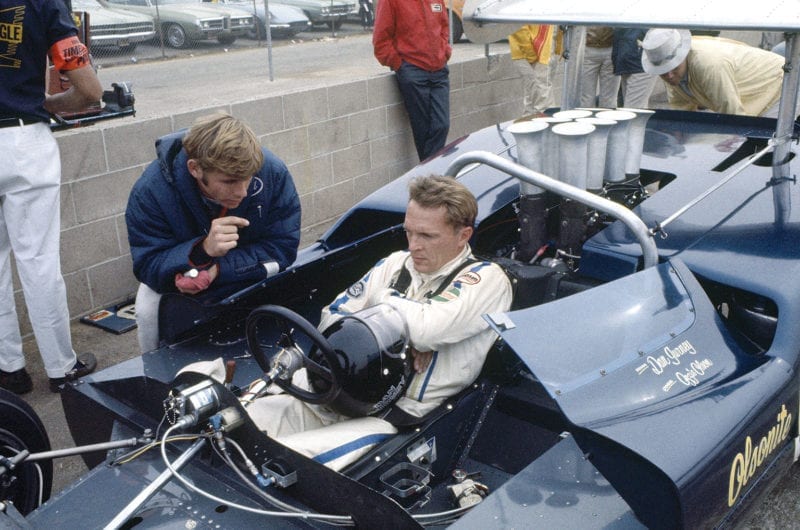
In Can-Am ‘McLeagle’ in the pits at Riverside ’69
Motorsport Images
Also in ’62, Dan paid his first visit to Indianapolis. He’d never seen the place before, and took his driver’s test in an old Zink Offy roadster. “I told Zink’s chief mechanic, Denny More, that the car felt like it was going to spin all the time, I had no confidence that it wasn’t going to bust the tail loose, and could he give me a little bit of push – which is what they call understeer at Indy. And he just said, ‘No’. One of those old-time chief mechanics, they were in charge, they didn’t have to do anything they didn’t want to. It was a shock to me. I flew to Europe to do the Targa Florio for Porsche, flew back, and tried one of Mickey Thompson’s new cars, with an alloy pushrod Buick V8 in the back. Right away it felt good.” He qualified it eighth, and ran in the top 10 until the transmission failed. The Gurney fascination with Indy had begun.
“I knew a mid-engined car was the way to go at Indy. Colin Chapman had never been, so I bought him a round-trip ticket so he could take a look. Then I introduced him to some Ford people in Detroit.” Out of that came a deal for two Lotus-Fords in the 1963 race. During March testing, to the consternation of the Indy establishment, Dan sensationally lapped at over 150mph. But in qualifying in May he hit the wall. “The Dunlop ally wheels were cracking. Part of why I hit the wall was because we didn’t have enough wheels to go round, and I had to go out on Jimmy’s set. He was using more negative camber than me and his tyres were worn differently. I did the race in the spare car, finished seventh.” In 1964, with the new Ford four-cam V8, the team’s Dunlop tyres weren’t up to the task, which put Gurney and Clark out.
In sports cars, Dan scored the Cobra’s first FIA Championship win in the 1963 Bridgehampton 500Kms, and in 1964 he was part of Carroll Shelby’s effort to wrest the GT Championship from Ferrari. At the Targa Florio the leaf-sprung Cobra wasn’t ideal for the bumpy, tortuous 45-mile circuit, but Dan and Jerry Grant got up to second place. “Once you got used to all the banging and crashing, the Cobra had good brakes, a lot of tyre on the road, lots of horsepower. The aerodynamics weren’t great, but we raked the windshield right down, so Jerry and I looked over the top, and that was worth 10mph. On the straights in Sicily we were pulling 160. It wasn’t too predictable when you had to move to the edge of the road to overtake another car, but power-on cornering with the tail out was a lot of fun.” Eventually the rear suspension broke, but Gurney heroically nursed the car home eighth, going the full distance to take the class win. “When I finally crossed the line the pits were deserted. I found the team in a restaurant having dinner. They couldn’t believe I’d made it to the finish. I just looked at them, turned round and left. I wasn’t terribly pleased.” At Le Mans that year he had the more slippery Daytona Cobra coupé, taking the GT class and a fine fourth place with Bob Bondurant, and he won the GT category in the Goodwood TT with third overall.
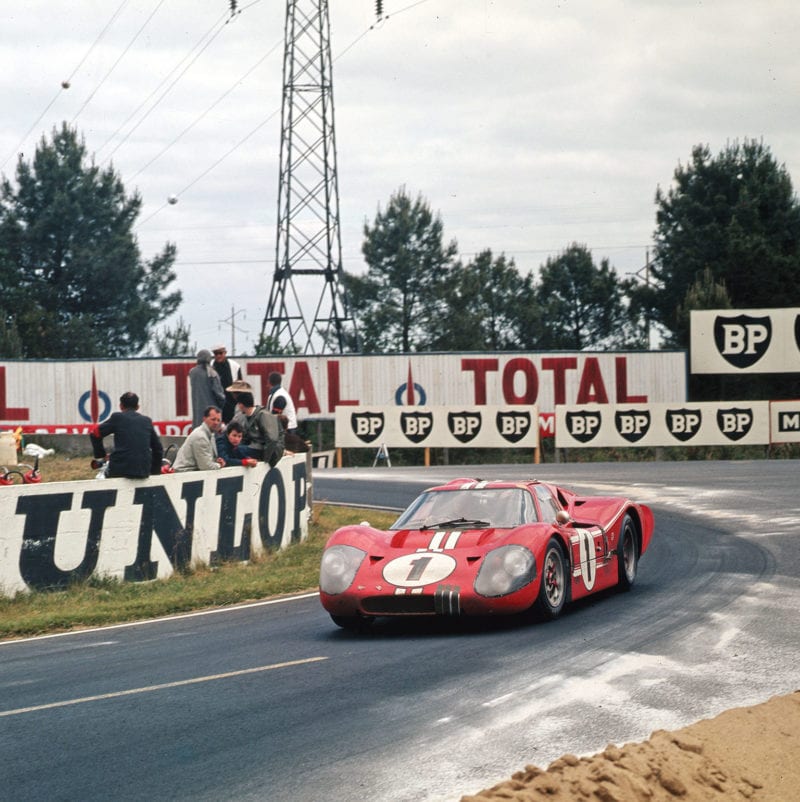
Victory in 1967 Le Mans with Foyt and Ford MkIV led to famed champagne moment
Motorsport Images
When Porsche left Formula 1 at the end of 1962, Dan signed for Jack Brabham’s new team. “Jack ran a tight operation – we had one mechanic per car – but Tauranac produced a car that was awfully good, handling-wise. I’ve been accused of constantly tinkering with the handling of my cars but, with the Brabham, my mechanic Tim Wall and I hardly ever changed anything. Slow tracks, fast tracks, it was good everywhere. Spa was a great place to learn your level, compare yourself with the others. I think I was the only guy then who could get through the Masta kink without lifting, because I’d learned at Indy how to deal with really high-speed corners. At Spa in 1964 I was leading by over half a minute – and I started to run out of fuel. I dived into the pits and yelled at Tim: ‘Gas! I need gas!’ But he’d loaded everything back in the transporter to go home. No gas. I drove on, but I ran dry half a lap later, and Jimmy won.” In three seasons, Dan led a lot of races for Brabham, but only won two: at Rouen – the marque’s first victory in a championship round – and in Mexico City.
His timing was not always ideal. Soon after he left Ferrari, it won the championship. Same with BRM; same with Brabham. But when the new 3-litre rules were announced for 1966 he laid plans for a Formula 1 challenger of his own. He’d set up All American Racers with the blessing of Goodyear, and run his own Lotus at Indy in 1965. Now the idea was to build and run cars in USAC and F1 using the same basic design, one with the four-cam Ford V8, the other with a new V12 commissioned from Weslake in England. Exquisitely engineered, the cars were called Eagles, and boasted a distinctive beak-shaped air intake.
The F1 car, after using an elderly 2.7 four-cylinder Climax as a stopgap, got its new V12 late in 1966. “The guys at Weslake did a terrific job with the budget I was able to generate. The engine was basically very sound, although its oil scavenge system wasn’t up to it. And it was less powerful than we’d hoped – the most we ever saw was 393bhp, which was a bit shy of the early DFV’s 420.” But in 1967, despite its power handicap, the F1 Eagle started to go really well. In the Race of Champions at Brands Hatch Dan took pole and won both heats and the final, holding off Lorenzo Bandini’s Ferrari.
Racing in F1, USAC, sports cars and Trans-Am all at once required incredible stamina, and Dan’s schedule from late April to mid-June that year bears repeating. He flew to Texas to drive a Mercury Cougar in the Green Valley 300 at Smithfield, and won. Back at Indy, his Ford four-cam-powered Eagle set fastest practice lap at 163.8mph. Then the flight to Europe, to Rye to check on the V12 engine programme at Weslakes, and to Monaco for the Grand Prix, where he ran third until the injection pump belt broke. Overnight flight back to America, straight to Indy qualifying, and at 167.9mph he was just pipped to pole by Mario Andretti. Race day at Indy, a Tuesday, and Dan was running second to Parnelli Jones’ STP Turbine when rain stopped the race. It was re-run on Wednesday, when Dan should have been on the plane to Zandvoort for the Dutch GP. He took the lead when Parnelli spun – only to be delayed by a jamming fuel tank valve, which led to engine failure. By Friday morning he was at Zandvoort with a lighter, magnesium-monocoque F1 Eagle, and qualified second behind Graham Hill in the new Lotus 49. In Sunday’s race he was holding fourth when the metering unit failed. Monday he stayed at Zandvoort for a test, Tuesday he was back at Rye, Wednesday he crossed to France for the Le Mans 24 Hours. Sharing a Ford MkIV with AJ Foyt, he won at record speed. Tuesday another Goodwood test, Thursday to Belgium for the next GP – and a historic win with the Eagle.
So the two greatest victories of Dan’s career happened on consecutive weekends. “AJ was a superstar, a damn fine engineer and a great race driver. He hadn’t been to Le Mans before; it was my tenth time, and I persuaded him it wasn’t a race, it was an endurance contest, and we had to be kind to the car. He left it to me to set the car up – the key was how little spoiler you could get away with at the back and still take the Mulsanne Kink flat. So we were sensible in practice, and only ninth-fastest. The Ford people were going nuts: ‘What’s wrong with the car, Dan?’. I said, ‘The car’s fine.’
“By the second hour we were leading, and by five in the morning we were six laps ahead of the Lodovico Scarfiotti/Mike Parkes Ferrari P4. I knew that the Ford’s Achilles heel was its brakes. You did 213mph down the straight, and then you had Mulsanne Corner. The brakes weren’t really up to that kind of punishment, and if you got brutal you could probably destroy them in 10 laps. So I’d back off soon after the hump before Mulsanne, let the car slow down on the over-run to about 150, and then brake. Parkes was right behind me, even though he was six laps down, and when he was in my slipstream I could still pull away at maybe 2-3mph. Then I’d do my early back-off, and of course he’s all over me, flashing his lights, trying to goad me into killing my brakes. After four or five laps of this it started to get to me, so coming out of Arnage I pulled onto the grass verge and stopped. And he pulled over and stopped behind me. Here we were, running first and second at Le Mans, no problem with either car, sitting on the verge. After 15 seconds or so he got embarrassed and drove on. Once he was down the road I drove on too, and about seven laps later I passed him, but keeping to my rigid discipline of preserving the brakes.” The Ford was still four laps ahead of the Ferrari when the flag fell at 4pm on Sunday.
“On the rostrum it was one of those moments: it felt so good to have won Le Mans at last, and they handed me this magnum of champagne. All the photographers were standing below with their expensive cameras, looking expectant, so I just put my thumb over the end, shook up the bottle, and sprayed it everywhere. Hank the Deuce [Henry Ford II] and his new bride were up there as well, and I got them in the firing line too.” Gurney had initiated a routine for thousands of podia to come. On a shelf in his office, he still has that bottle.
Seven days later the American national anthem rang out over Spa. Dan missed the pre-race briefing, which told the drivers that the starting flag would fall any time after the 30-seconds board. When it did fall Dan, in the middle of the front row between the Lotus 49s of Jim Clark and Graham Hill, wasn’t even in gear. He was eighth going up the hill into Eau Rouge. By lap two he was third, and by lap 21 the Eagle was in the lead. Setting a 148.85mph lap record around the old high-speed road circuit, he won by over a minute. He’d done it in his own car and with his own small team, on far too tight a budget, exactly one year on from their F1 debut. It was an extraordinary achievement. “Standing up there while the The Star-Spangled Banner was played was mighty high. I’ll tell you something that addresses it a bit. In those days, flying back and forth over the Atlantic in heavy weather got a bit iffy sometimes. I used to say, ‘Come on, aeroplane, don’t go down, I haven’t won a Grand Prix in an Eagle yet.’ After Spa I’d say to the aeroplane, ‘If you want to go down now, it’s OK…’”
There was nearly another Eagle victory that year, in the German GP. Dan was always brilliant at the ’Ring, and with three laps to go he had a huge lead when a driveshaft universal joint broke. “That was one of the tough ones. Tim Wall [who’d followed Dan to Eagle from Brabham] said afterwards: ‘It was my fault. For the ’Ring I like to grind more clearance on the UJs for full droop and full compression over the bumps, and I was so busy I didn’t do one side.’ I told him it wasn’t his fault. Tim was a terrific guy.”
Dan’s versatility continued to shine. He drove his USAC Eagles to victory from Mosport to Sears Point, Brainerd to Riverside. For Can-Am he developed his own McLaren, so different from the works cars it was dubbed the McLeagle. AAR developed the Barracuda Trans-Am cars for Chrysler, and in NASCAR Dan made a speciality of the Riverside 500, winning it five times. “Those big stockers weighed nearly two tons, they’d run 160mph down the back straight, and they had drum brakes. If changing direction in an F1 car is like a water-bug darting across the surface of a pond, driving a NASCAR sedan on a road circuit is like trying to dock an aircraft carrier. But it isn’t any easier or harder to win a race with a water-bug or an aircraft carrier. It’s just different. In the end you still have four patches of rubber on the ground, and various ways of getting those patches to move around. It’s like people used to say of oval racing: all you have to do is turn left. But you’re up against the guys who are best in the world at turning left. A 100-yard sprint is pretty simple, until you come up against the best 100-yard sprinters. Each is a separate discipline, with good people applying creative thinking, and coming up with little increments.”
At the end of 1968, Dan took the bitter decision to wind up the Eagle F1 programme, essentially because Goodyear’s backing dried up. “Let’s just say there were a lot of people trying to eat at the Goodyear trough, and some of them had more influence than others. The same old political thing, moves made when I wasn’t at the table: maybe I have to blame myself for that. But it was a heart-rending choice to have to take.” Nevertheless, the Indy programme continued apace. He was second in the 1968 500, using a stock-block engine: the winner, Bobby Unser, also drove an Eagle, with turbo Offy power. In 1969 he was second again. In 1970, his final 500, he was favourite to win but, in a fighting drive with a difficult car, he made 11 pitstops – and still finished third. After Bruce McLaren’s tragic death that year he briefly partnered Denny Hulme at McLaren in F1 and in Can-Am too, winning the Mosport and St Jovite rounds. Then he hung up his helmet.
“I’d lost maybe half a per cent of my motivation, and unless you’re 100 per cent as a driver you shouldn’t be doing it. By 1970 I felt almost lonely on the grid, looking around and feeling who was missing. You’d see these bright-eyed youngsters who couldn’t wait to roll the dice, but if you studied what caused the demise of this guy and that guy, you realised some of it couldn’t have been foreseen and you’d have had a hard time avoiding it. That started to add up.
“I was always interested in safety. I was the first car racer with a full-face helmet: Bell developed that for motorcycle speedway, where the clods of dirt could really punish a rider’s face. But I never sided with the group that began to say, ‘We’re not going there because it’s too dangerous.’ I always said, ‘I’ll be there’, because that was racing, that was the way it was, that was what you were there to do. I loved circuits like the Nürburgring, Spa, the Targa Florio, Rouen. When I went to Europe in 1958 people were getting used up. I was there when Luigi Musso was killed at Reims, and then Peter Collins at the ’Ring. It wasn’t as though you woke up one morning and said, ‘Hey, this is dangerous.’ Some drivers think, ‘It can’t happen to me’, but I knew it could happen to me.”
All American Racers remained energetically busy, and team and customer Eagles went on winning: the statistics show 78 victories and eight championships, including Indy again in 1973 and ’75. There were Formula A and 5000 chassis, even an Eagle Formula Ford, and 18 generations of Indycars up to 1986. Then came the Champ Car and IMSA variants during a 15-year relationship with Toyota. The 1991/3 Toyota-powered GTP was the most successful Eagle ever, winning 17 straight races: some of its lap records still stand, more than 15 years later. In 2002 the Alligator was announced, fruit of Dan’s lifelong passion for motorcycles. His long legs gave him the idea of a long-wheelbase design where the rider sits low between the engine and the rear wheel. “I ride my Alligator most Sundays with my sons. All five are talented riders and drivers.” Youngest son Alex is a seriously quick professional racer: 2007 Rolex Daytona Prototype champion in Grand-Am with Jon Fogarty, he currently leads the 2009 series.
Our conversation ranges over many topics that stimulate Dan’s sharp thinking: Boeing’s experiments with BWBs, or blended-wing aircraft; the oil industry’s effect on world politics; and race track design. “People laying out circuits never appreciate that every inch you move the spectators further back, you give them a corresponding reduction in enjoyment. You can keep them safe by putting them on the inside of a turn, and siting them higher up.” And more stories, told in Dan’s self-deprecating way: like persuading the authorities that running an F1 race around the streets of Long Beach was a good idea. Or turning down a drive in the Cannonball Run in a Ferrari Daytona in 1971, and then deciding hours before the start, ‘Hell, let’s do it’ – and winning it. “It took us 35 hours from downtown Manhattan to Redondo Beach, California, and we only got one speeding ticket. Three lawyers in a Cadillac were second. They got seven tickets.”
But that must do for your amuse-bouche. For the full tale you’ll have to wait, like me, for the autobiography of one of the greatest drivers, and one of the nicest guys, in all of motor sport history.
